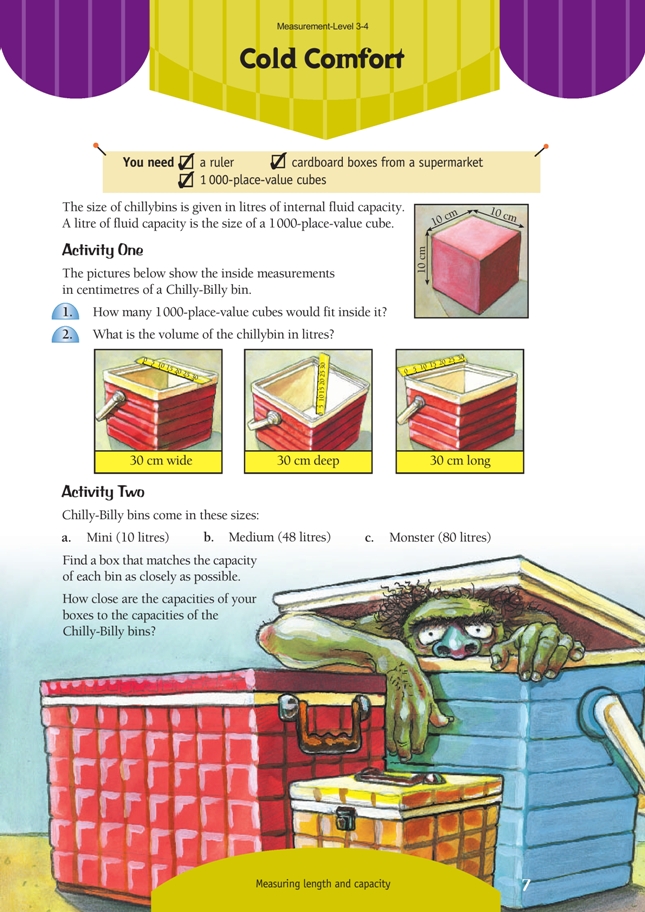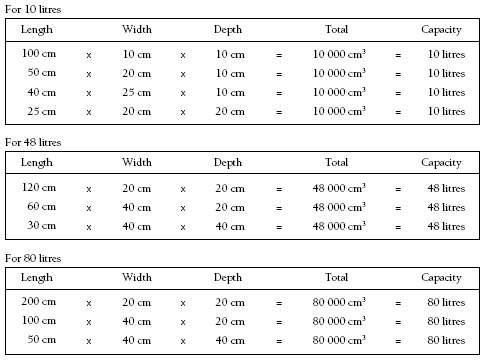This is a level 3 measurement activity from the Figure it Out series.
A PDF of the student activity is included.
Click on the image to enlarge it. Click again to close. Download PDF (407 KB)
measure volume of a cuboid
cardboard boxes from a supermarket
FIO, Level 3-4, Measurement, Cold Comfort, page 7
1 000 place-value cubes
Activity One
In this activity, students work with the equivalent volumes of 1 000 cm3, a 1 000-place-value cube, and 1 litre. A 1 000-place-value cube is 1 000 cm3, and the bin is 30 centimetres x 30 centimetres x 30 centimetres (or 27 000 cm3), so three cubes will fit in the width, three will fit in the length, and three will fit in the depth. 3 x 3 x 3 (or 33) = 27, so 27 place-value cubes fit in the bin. The students may like to model this with place-value cubes.
A 1 000-place-value cube is easy to make. Cut a 10 centimetre x 10 centimetre x 10 centimetre block of wood and draw centimetre gridlines on the surface. It can be used to remind the students what a 1 litre volume looks like.
A good way of relating 1 000 cubic centimetres to 1 litre is to shape a bit of Plasticine into an exact 1 cm cube. Take a measuring cylinder (available from the science room) and half fill it. Then carefully lower the Plasticine cube into the water. The easiest way to do this is pick it up with a toothpick. Take note of how much the water level rises (1 millilitre). This shows that 1 000 cubic centimetres is 1 000 millilitres, which is 1 litre.
A 1 000-place-value cube and 1 000 cm3 both have the same volume as 1 litre. The students can use their answer to question 1 to answer question 2. If 27 place-value cubes fit in the bin, the size of the bin must be 27 litres.
The students could also calculate the volume using the formula V = L x W x D (where V = volume, L = length, W = width, and D = depth). 30 x 30 x 30 = 27 000 cm3, so the volume is 27 litres.
Activity Two
In this activity, the students are reversing the process they used in Activity One. In that activity, they used the dimensions to find the capacity. Here, they use the capacity to find the dimensions.
The students could begin by estimating what size supermarket box would hold 10 litres, 48 litres, and 80 litres. They could then check their estimate by measuring the dimensions and calculating the capacity.
Another approach is for the students to make a chart showing some dimensions for each box that would result in the required capacity and then select one that would be practical to use. For example:
Note that these measurements should be for the inside of the container.
Answers to Activity
Activity One
1. 27 cubes
2. 27 L
Activity Two
Practical activity. The most likely side lengths of the
boxes that you find would be close to:
a. 25 cm x 20 cm x 20 cm
b. 40 cm x 40 cm x 30 cm
c. 40 cm x 50 cm x 40 cm
However, you may come up with boxes with other measurements that are close in capacity to 10, 48, and 80 litres.

